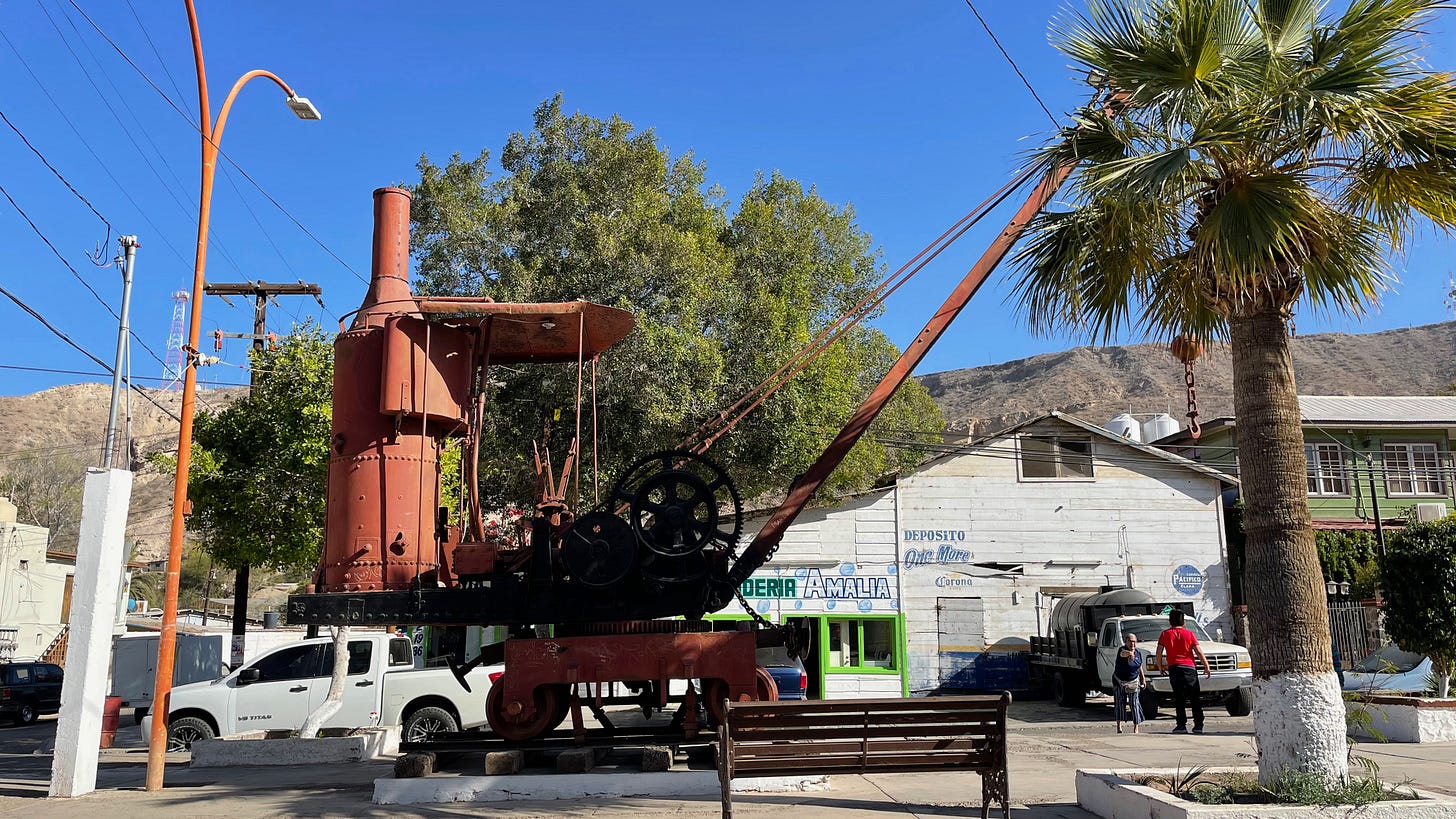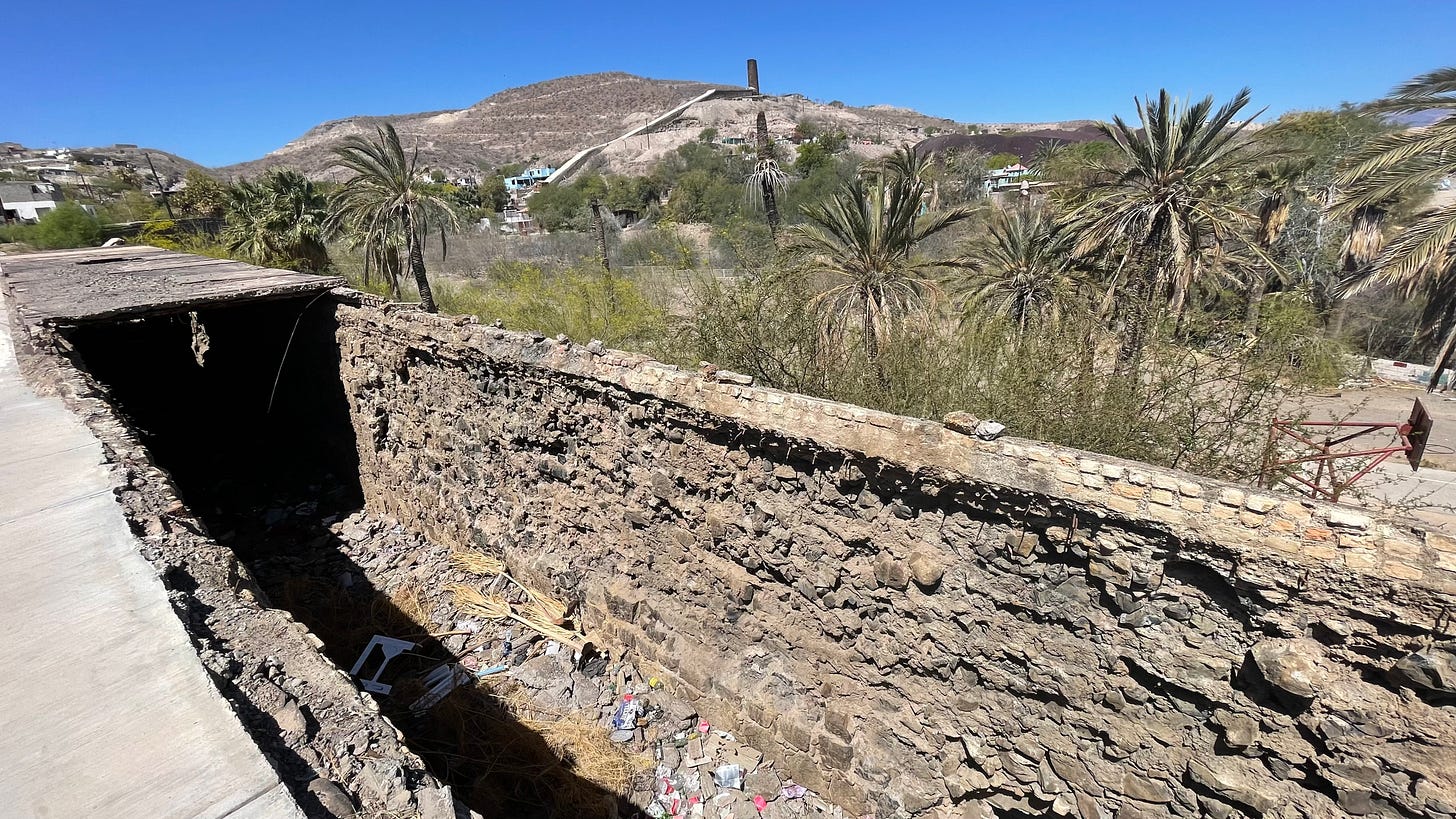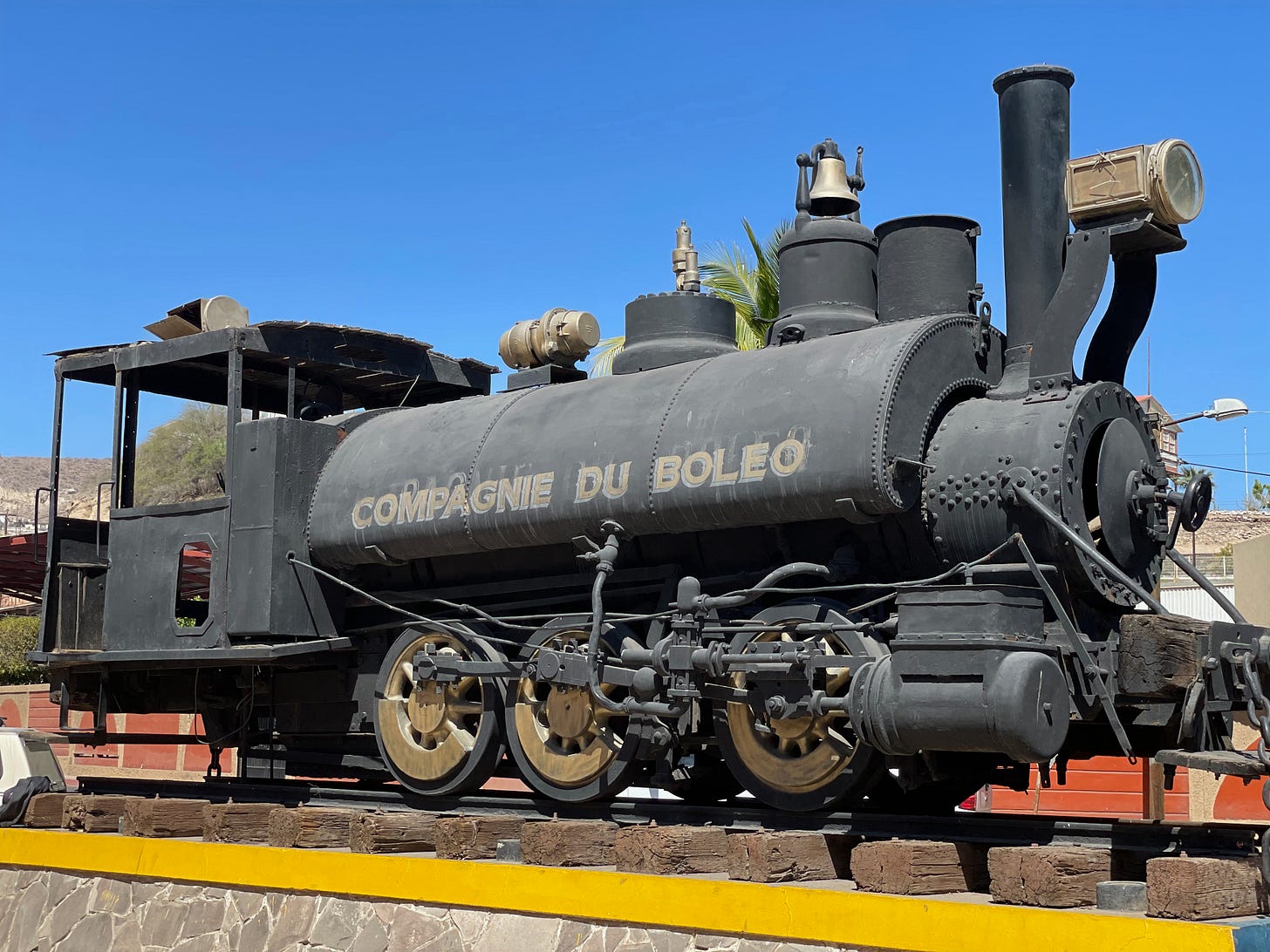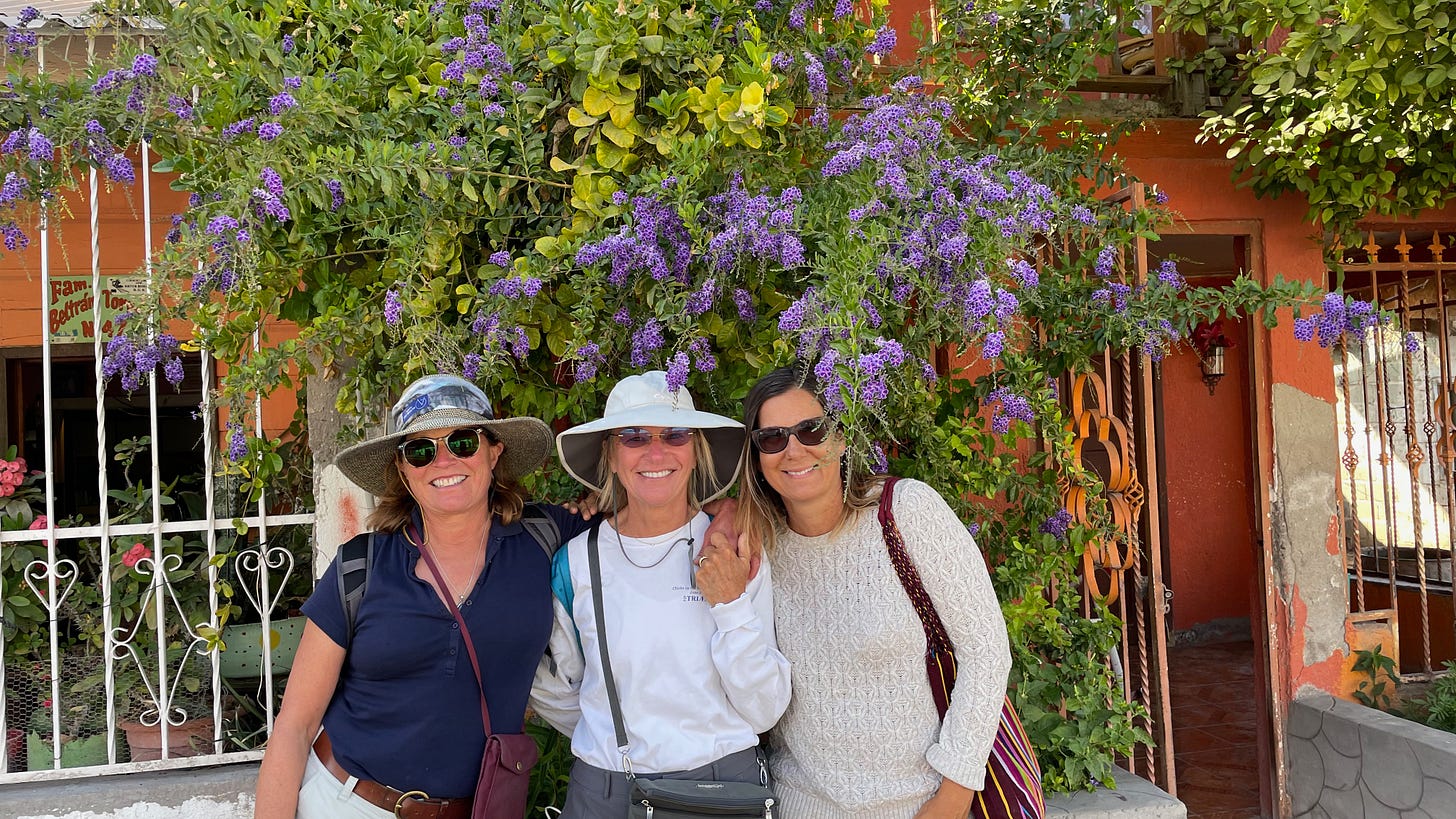Time Slip
Sailing North to Santa Rosalía
So, we need to come clean about something. As you might have noticed, it’s been a little while since our last post: two and a half months, to be exact. And we haven’t just been floating around in an exotic anchorage, with fruity rum drinks under little paper umbrellas in our hands. (OK, maybe we’ve been doing a little of that, but without the umbrellas and the fruit.) We promise to catch you up on all our most excellent adventures over the next few issues, and we’ve got a lot to share, because we’ve been busy!
After the First Annual Charlie Allen Regatta, we hightailed it out of Conception Bay, heading north for Santa Rosalía, about a hundred miles north. In order to break up the mileage, the plan was to make two overnight stops on the way, first at Point Chivato, then at Isla San Marcos. Point Chivato is known for a huge abandoned resort hotel complex, an airstrip, and a beach completely covered in shells. Isla San Marcos has a huge, operating gypsum mine on the west and south sides, and a small anchorage on the north west corner.
We had beautiful weather as we sailed out of Conception Bay, a bit ahead of the beam until we were out of the bay, and then backing until it was a bit behind — ideal sailing.1 The wind held nearly until we reached Punta Chivato, where we dropped anchor.
Punta Chivato
When we arrived, the swell was wrapping around the point to the north east, and rolling across the anchorage. Since the boat was rolling uncomfortably in the swell, we dropped our flop stopper.
The flop stopper is a large aluminum Venetian blind that hangs horizontally from a halyard off the top of the mast, held out to the side of the boat by a pole, and sinks down about ten feet into the water. As the boat rolls, the slats in the blind open, allowing the flop stopper to easily sink, but as the roll goes back the other way, the slats close, turning the device into a horizontal door, which resists the roll.
To our chagrin, the wind continued through the night, and the swell continued to roll through the anchorage, as the boat rolled, staining against the flop stopper. I spent a bit of time on deck watching it, as it was nearly being pulled out of the water at times, so violent was the rolling. It was a rough night’s sleep, and we woke up tired and irritated at the constant motion, and got underway as soon as we were able to get the boat ready.
As we headed north in the thin morning light, the wind gave us a good start, and then slowly faded into mid-morning. As we approached Isla San Marcos, and crossed under its south side, we had a clear view into the gypsum mines and the clouds of white dust the mining activity send floating across the southern anchorage.
As we turned north along the western side of the island, the wind picked up a bit, and we started making decent time under sail again. Not looking forward to another night at anchor, in what looked to us like a very small anchorage without much protection, Donna and I decided to forego the night on anchor and head straight into Santa Rosalía for a change of pace.
Santa Rosalía
The Santa Rosalía harbor is enclosed by a low rock jetty, and scattered with various detritus, including at least one fishing boat, half sunken, and thrown up against the inner side of the jetty. There are old pilings barely slowing the crumbling of the decrepit piers they hold up from their inexorable advance into the water as the years roll by. The remains of a massive smelting facility dominate the northern end of the harbor, hulking and burnt out.
The friendly staff of the Fonatur marina was out on the end of the dock awaiting our arrival though, as we called on the VHF just before entering the harbor. The end tie was empty, making for a super easy docking situation, and once tied up, a quick chat with the dock staff revealed that the next slip over was open as well, and a bit more protected from any swell entering through the nearby harbor entrance. We moved over, shared a beer with the dock staff, and talked a bit about the best restaurants in town before hooking up the hose, and giving the boat a well-deserved rinse, finally heading into town to look for something tasty to eat!

All in all, we spent nearly a week in the Santa Rosalia harbor, enjoying the opportunity to walk into an interesting town that wasn’t bending over backwards to cater to tourists. Most residents here still work in the various mines, which have reopened in recent decades, as the prices for various metals has made the mines lucrative again.
The town was built by the French mining company Compagnie du Boleo in 1884, in order to take advantage of local copper mines. We found the architecture and the feel of the town to be markedly distinct from other towns in Baja California Sur, since most of the construction is wooden, with a fair amount of gingerbread still in place. Attractions include the Santa Barbara church, a mining museum, the Victorian-era Hotel Francés, a bakery, and an array of local restaurants, tortillerias, grocery stores of various sizes, and other businesses.

As a result of the town’s French origins, the bakery is much talked up. Our experience of the bakery was more or less on par with other Mexican bakeries. To our taste, things end up a bit too sweet, and without the harder chewier crusts we like, with a fine crumb, maybe the result of higher temperatures impacting the rise of the dough. The sugar donuts, called “doñas” were excellent, though!

The mechanized tortillerias aren’t to be missed! These are small shops, mainly dominated by large mechanical tortilla presses, with moving wire racks which take the balls of dough, press, bake, cool, and stack them, before the operator drops them into bags in warm, tasty stacks of ten. They freeze well, although they’re best warm and fresh.
An Unusual Parade
A day or two before our departure, we went out for dinner, walking the length of the town to work up our appetite. At the top of the town, we had reached what looked like a large dirt lot, with what looked like a flea or farmers market closing down, so we turned around headed for our restaurant. As we were being seated on the porch of the restaurant, the sound of drums and clapping started in the distance, and people started filtering down the street, the crowd eventually swelling to a large parade. Everyone was clapping with a very particular syncopated rhythm, a large group of masked paraders led the group, and the crowd was largely following, with one man carrying a large cross down to the Santa Barbara church.

It turns out, a sizable part of the town’s population is descended from the native Yaqui people imported from across the Sea of Cortez, and the region around Guaymas. These people were allowed to keep aspects of their cultural identity, although they were converted to Catholicism. We had arrived during Santa Semana, or Holy Week, and witnessed one of these syncretic unions of the Yaqui culture and the carrying of the cross to the church for Easter weekend.
Leaving Santa Rosalia
At long last, we were ready to start heading north again. A few of us had decided to leave together, and woke up around four thirty in the morning to do the final preparations to get underway for our nearly hundred mile sail north to San Francisquito.
Early morning sailing is always a treat, and our departure rewarded us with early moonlit views of the city lights reflected in the oily black waters under the midnight blue sky, as the sun slowly rose over the east, and a beautiful sunrise.
The “beam” is the width of the boat, and by extension the direction across the boat. When sailing with the wind on the beam, you’re said to be on a “beam reach” which is the fastest point of sail.










I will never get sick of your sunset (and sunrise and moonrise) over the water photos. I love how you make friends in every port.
So it’s Labor Day and hope you two are having fun. Enjoyed your post as always
Love, Marie